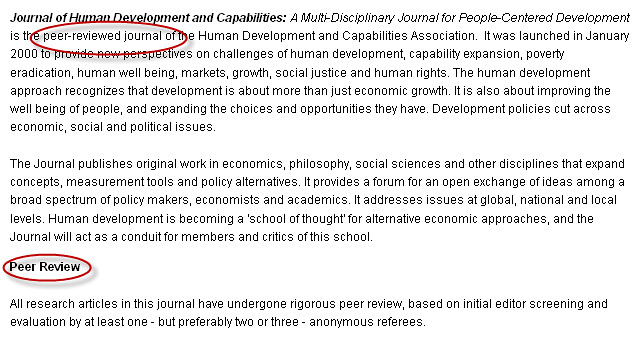Date submitted and accepted information is easiest to find if you open the PDF. Usually this information will be in the bottom corner of the first page of the article.

One of the best places to find out if a journal is peer-reviewed is to go to the journal's website (just Google the journal title).
Most publishers have a website for a journal that tells you about the journal, how authors can submit an article, and what the process is for getting published.
If you find the journal's website, look for the link that says "information for authors," "instructions for authors," "submitting an article" or something similar.

Research articles - These are your standard scientific articles. Most often published in peer reviewed journals, primary research articles report on the findings of a scientist's work. They will almost always include a description of how the research was done and what the results mean.
Review articles - Published in peer reviewed journals, but seek to synthesize and summarize the work of a particular sub-field, rather than report on new results. Can provide helpful background information.
Editorials/Opinion/Commentary/Perspectives – An article expressing the author's view about a particular issue. These articles can be well researched and include a lot of citations to the peer reviewed literature, or simple items without citations, but are not themselves peer reviewed.
Trade publication articles - These publications are often aimed at professionals (doctors, brewers, teachers) or particular disciplines. Articles in these publications may be several pages long and include a few references, but they are usually summarizing research published in other publications or reporting on industry news. These can be helpful for keeping up with your discipline or finding a research topic.
News – Science news articles can be found in a wide variety of publications. Popular newspapers and magazines, trade publications and scholarly publications can all have science news articles. These articles often will refer to a recent study published as a primary research article.
Blog posts - Blogs can be a great way to get involved in the scientific community, and many scientific blog posts can point you back to the peer reviewed literature.
Technical Reports – Government agencies and NGOs often do scientific work. The reports they produce are not often peer reviewed, but can be an important part of the scientific literature.
Dissertations/Thesis – These are the final products that result from research conducted for a PhD or a Masters degree. While they undergo exhaustive review by academic advisers and committee members, they wouldn’t be considered “peer-reviewed”.
Adapted from Bonnie Swoger's Types of Scientific Literature post.
